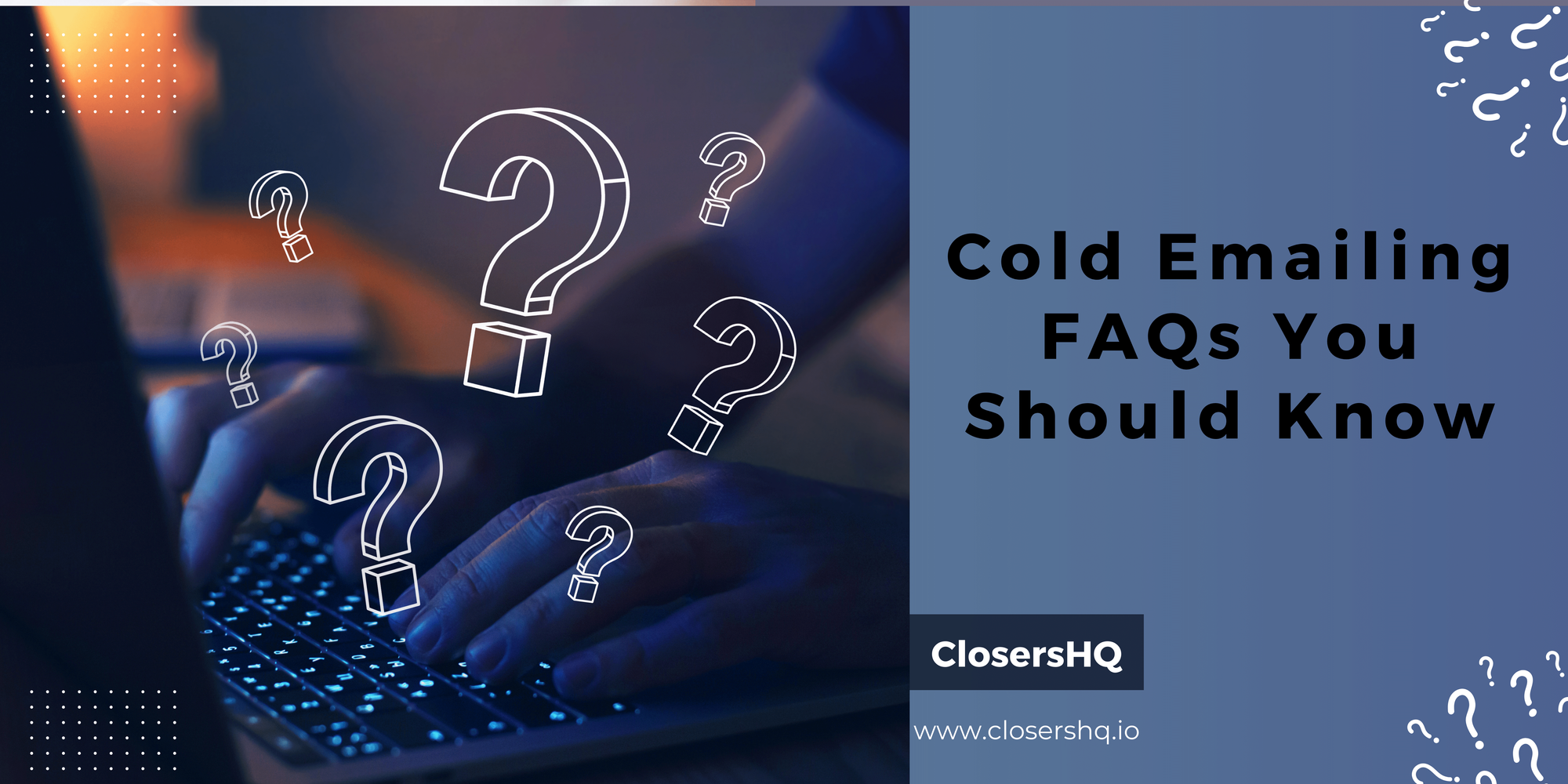Introduction
In today's fast-paced and competitive business environment, cold emailing has become a popular strategy for reaching out to potential clients, customers, and partners. It is an essential tool for communication in both personal and professional settings. However, many individuals and businesses still have questions and concerns when it comes to crafting and sending effective cold emails. In this article, we will delve into some of the most frequently asked questions (FAQs) about cold emailing and provide expert insights and tips to help you successfully navigate this communication method. Whether you are new to cold emailing or looking to improve your existing strategy, this article will serve as a valuable resource for answering your questions and helping you achieve your business goals.
So, without any further ado, let's dive in and uncover the answers to the most common concerns surrounding cold emailing.

What email providers are great for cold emails?
When it comes to sending cold emails, choosing the right email provider is essential. A good email provider not only ensures that your email is delivered to the recipient's inbox, but also provides features that can help you track the success of your campaign.
The best email providers for cold emails should provide features such as high deliverability rates, easy-to-use interface, and powerful automation tools. They should also offer analytics tools so you can track your campaigns and measure their performance.
While there are several options available, some email providers are better suited for cold emailing than others. The providers that are great for cold emails are those that prioritize email deliverability and have features that protect your email account from being flagged as spam.
One of the top email providers for cold emails is G Suite by Google. G Suite, now Google Workspace offers professional email addresses with your own domain name, making your email appear more credible and trustworthy to recipients. It also provides an easy-to-use interface, customizable templates, and email tracking features that allow you to monitor the performance of your emails. Additionally, G-Suite has strong spam filters that reduce the likelihood of your emails being marked as spam by recipients, thus increasing the chances of your email reaching its intended audience.
Undoubtedly, though a little more costly, Google Workspace outperforms most other providers when it comes to sending email campaigns, immediately followed by AWS SES. These providers have robust email deliverability systems that ensure your emails reach your recipients' inboxes, rather than being caught in spam filters. Other email providers such as Microsoft365, Zoho Mail and Sendinblue are also great options for cold emailing as they offer similar features and benefits. Sendgrid, Mailgun and AWS SES are equally great for sending transactional emails while Mailchimp, Vbout and Encharge are optimal picks for email marketing. When choosing an email provider, consider factors such as pricing, ease of use, and customer support. Ultimately, the right provider will depend on your specific needs and budget.
In addition to selecting a good mail provider, you need a good cold email automation software that can make the entire process easy and stress-free for you. While there are many such tools in the market, not all of them are equally good for cold emails. Therefore, it's important to choose an automation software such as ClosersHQ, that is specifically designed for cold emailing. These tools offer features that make it easier for you to create and send hyper-personalized messages at scale. They let you send spintax cold email, allowing you to create multiple variants and make use of sender rotation and other innovative features such as email tracking, automated follow-ups, and personalized email templates. They also offer advanced analytics so that you can track your campaigns and optimize them for better results.
Should you use free email providers for sending cold email?
Using free email providers for sending cold emails may seem like a convenient and cost-effective option, but it can actually harm your email deliverability and reputation. Most free email providers have strict policies and algorithms in place to identify and filter out spam emails. If you are sending a large number of cold emails from a free email provider, there is a high chance that your messages will be flagged as spam and never make it to the recipient's inbox. This can lead to a low email delivery rate, decreased open rates, and ultimately, a waste of your time and effort. Furthermore, using a free email provider for sending cold emails can damage your credibility and professionalism. Many recipients are wary of messages sent from free email providers as they are often associated with scams and other malicious activities.
Granted, free email providers are a great option for those who don't have a large budget for sending cold emails. But they come with certain drawbacks that should be taken into consideration before making a decision. For example; although free email services like Gmail, Yahoo, Outlook and Hotmail can be convenient and easy to use, they may not provide the level of credibility and trustworthiness that a professional email address can offer. Using a professional email address with a personalized domain name, such as john@companyname.com, can help establish your brand and make your emails appear more legitimate and trustworthy. This can also increase the likelihood of your emails being opened and read by recipients, as they are more likely to view your email as coming from a reputable source. These providers often have limited features in their free plans and may not be able to provide you with the analytics you need to track your campaigns' performance. In addition, many of these free services limit the number of emails you can send per day or week.
Overall, while using free email providers may be a convenient option for personal use, it may not be the most effective choice for sending cold emails in a professional setting, as they are not as reliable as dedicated Email Service Providers (ESPs). It is recommended to invest in a professional email service with a custom domain name for sending cold emails to ensure a higher email deliverability rate and maintain a positive reputation. The latter also offers higher limits on the number of emails you can safely send per day or week. This can help establish credibility and trust with potential customers, and ultimately lead to better success in your email outreach efforts.
Should you use email signatures?
When it comes to crafting effective cold emails, the use of email signatures is a topic of much debate among professionals. Some argue that email signatures can lend credibility and professionalism to an email, while others believe that they can be a distraction that takes away from the main message. Ultimately, the decision of whether to use an email signature in a cold email comes down to personal preference and the specific context of the email. If you choose to use an email signature in your cold email, it is important to ensure that it is simple, professional, and relevant.
Your email signature should include your name, job title, company name, and contact information such as your phone number and email address. You may also choose to include a link to your company website or a relevant social media profile. By including this information in your email signature, you make it easier for people to remember who you are, what you do, and how to get in touch with you.
However, it is important to avoid adding too much information or unnecessary graphics, as this can make your email signature appear cluttered and unprofessional. Ultimately, the goal of your email signature should be to provide the recipient with the information they need to contact you and learn more about your company, without distracting from the overall message of your email. In addition, it’s important to ensure that your email signature is consistent with your brand and messaging. This can include using your company logo and maintaining a consistent font and color scheme.
In conclusion, email signatures are a great way to add a personal touch to your emails and make them stand out from the crowd. When used correctly, email signatures can help build trust with your customers, increase customer engagement, and even generate leads. It gives them a clear picture of who you are and what your company is about. It also allows them to easily contact you if they have any questions or need more information.
Should you track open rates?
When it comes to sending cold emails, tracking open rates can provide valuable insight into the effectiveness of your outreach efforts. Open rates indicate how many recipients have actually opened and potentially read your email, which can help you understand if your subject line, email copy, and overall approach are resonating with your target audience.
Open rate tracking allows you to measure the effectiveness of your email campaigns and make adjustments accordingly. It also helps you to identify which elements of the message are working and which ones aren’t, and which time of day is most effective for sending emails, so that you can use the data to optimize your emails for better results. This will help you get more conversions from your campaigns and ultimately improve your ROI.
Tracking open rates is a crucial aspect of any cold email campaign and should not be overlooked. These emails are being sent to people who have no prior relationship with your brand, so tracking open rates helps you understand how well your message is resonating with your audience and whether or not your subject lines are compelling enough to grab their attention. Additionally, tracking open rates can help you identify which prospects are more engaged and interested in your offer. This information can be used to personalize your follow-up emails and tailor your messaging to better resonate with their needs and interests.
However, it's important to keep in mind that open rates aren't the only metrics that matters when it comes to cold email outreach. Just because someone opens your email doesn't necessarily mean they're interested in what you're offering. It's also important to track responses, clicks, and conversions to truly gauge the success of your cold email campaign. By tracking a variety of metrics, you can gain a more comprehensive understanding of how your outreach efforts are performing and make adjustments as needed to improve your results.
N/B: Open rate tracking may affect deliverability in some cases, as most mail providers are wary of links embedded into incoming email copies that serve the tracking role. This is because fraudsters could leverage this opportunity to include links that are used for malicious activities.
